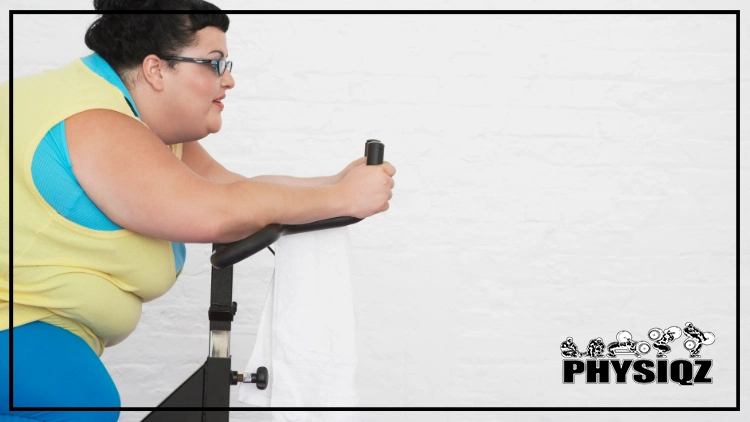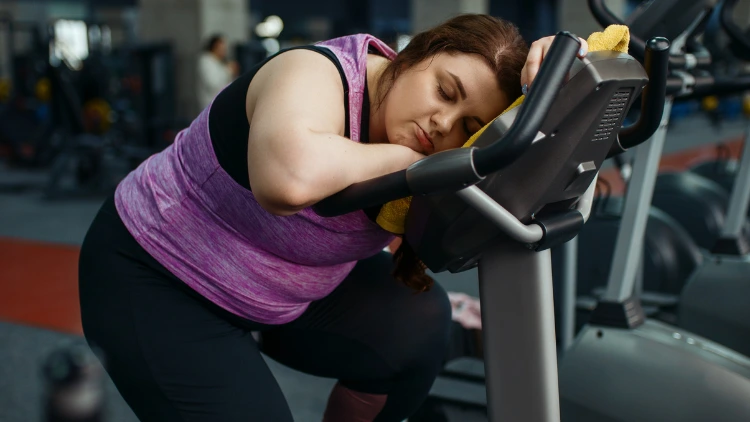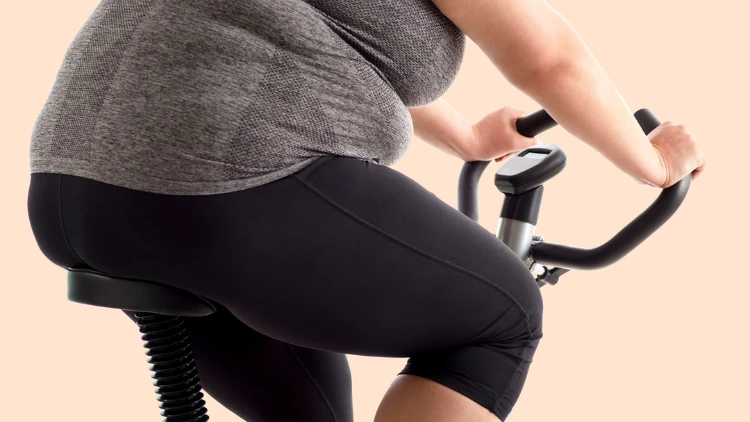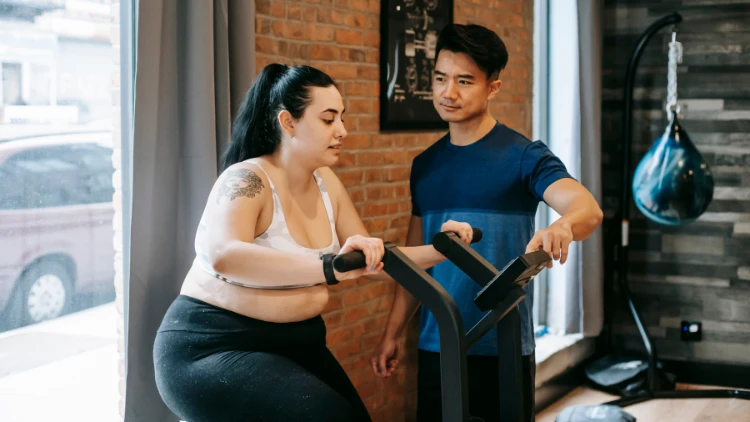
Before jumping into a new routine, it is essential to find out if it is something that is plausible for your life; so, when it comes to Peloton for overweight beginners, it is smart to do your research.1
Instead of just blindly purchasing a piece of gym equipment and going about it alone, take a moment to read my overweight Peloton beginner story and to find tips and advice that can help you along your journey.
In addition, I’ll cover if a Peloton is worth it, when you should consider getting one, how often you should ride, the best classes, and some beginner diet and exercise tips that are scientifically proven to help with weight loss.
Is Peloton Good For Out of Shape Beginners?
The Peloton bike may seem intimidating, and finding out if it is a good choice for out of shape beginners makes sense before making a big purchase. What I can tell you, from personal experience, is that it is actually a great tool for those who have rarely (or never) worked out.
My job has always been a big priority for me, but when my weight started climbing and lab work from the doctor came back as less than impressive, it was time to reevaluate my priorities. I’ve never been a person who enjoys working out, so the last thing I wanted to do was dedicate a large amount of time going to the gym.

Source: nomadsoulphotos via Canva.com2
So, instead of forking over a monthly payment to a gym where I know I’d never show my face, I started thinking about things that I might not hate to use as a means of movement, and the only thing I kept coming back to was remembering that I used to enjoy riding a bike as a kid. Buying a bike was an option, but I was afraid I’d use weather as an excuse to not work out; this is when I started looking at stationary bikes.
The Peloton was always a front runner because of the robust app that can be paired with the bike. Not only is the Peloton a piece of gym equipment, it is also several classes and instructors all combined. After making the decision to create my own Peloton before and after journey, I placed my order, and it arrived in less than three weeks.
One of my favorite things about Peloton was how easy it was to get started. The bike was delivered and set up by technicians and I didn’t even have to lift a finger. The two things I did need to do before I got to pedaling was to adjust the seat and sign up on the Peloton app.
Both things were simple and I was able to watch a video to walk me through seat set up and signing up was just answering a series of personal details and preferences.
I slowly started adding cycling to my weekly routine; at first, just a couple of times a week for 15 to 20 minutes. After 2 weeks, I added another day and a few extra minutes. Before I knew it, it had been 2 months and I was already down 10 pounds!
If you have been on the fence about purchasing a Peloton and starting a workout plan, read on to see the advice I followed when starting my weight loss and health journey.
When Should an Overweight Individual Consider Purchasing a Peloton Bike?
Being overweight can be difficult and stressful and most people who are confronted with needing to lose some extra pounds are also faced with the task of how to accomplish that goal. There are many ways to exercise to help achieve weight loss, but finding one you enjoy really is the key to being successful long term.
If you’re considering Peloton as an option and pondering whether you can lose weight with Peloton, trying out a few spin classes could help determine if cycling is an exercise you enjoy.
Secondly, Peloton’s exercise app isn’t only available to those with Peloton equipment; plus, it also includes many exercises that don’t involve the bike at all. Consider signing up for the app, exploring, and trying out a few classes to test whether the classes are a good fit.
Committing to a large, expensive exercise apparatus can be intimidating, so luckily, Peloton offers a 30 day money back guarantee if it ends up not working out. Also, for those with an unrelenting fear of commitment, they also give the option for a monthly rental that can be canceled at any time.
How Often & How Long Should a Beginner Ride Peloton or Take Peloton Classes?
When determining a schedule for how often and how long to ride the Peloton as a beginner, first and foremost, it is important to consult your doctor. A physician will ensure you have no underlying health conditions that will cause you harm when transitioning into an exercise routine. Once cleared by the doc, there are a few ways to go about scheduling rides or Peloton classes.

Source: Science Photo Library via Canva.com3
The Centers for Disease Control and Prevention set a guideline that adults should exercise 150 minutes per week or 30 minutes per day.4 With this information, you can decide how best to work up to those times. Consider starting at 2 times a week for 20 minutes and build from there by either adding a day or upping the time time 20 minutes until you’ve built a custom routine you are able to sustain.
Alternatively, leveraging an existing Peloton workout plan could prove beneficial. A great place to start is the Peloton You Can Ride training program which is 9 classes spread out over 3 weeks at just 20 minutes each which allows for settling in and becoming familiar with different class styles and instructors.5
What Are the Best Peloton Classes for Overweight Beginners?
When seeking Peloton classes tailored for overweight beginners, considering recommendations from individuals who have achieved successful Peloton before and after weight loss transformations could be beneficial.
Even if a particular class isn’t labeled for beginners, a majority of classes are set to the pace and ability of the rider, which means there can be a big range of ability levels participating.
However, the following classes may be a good place to start:
- Easiest Peloton Instructor: Matt Wilpers is no pushover, but he is excellent for beginners and focuses on form, which is very helpful for those just starting off.
- Best Peloton Class for Weight Loss: The Peloton Tabata classes are top notch for burning calories. Although they are intense, you have the option of participating in classes that are just 10 minutes long.
- Most Fun Peloton Class: Cody Rigsby’s classes are highly recommended by many in the Peloton community. He is interactive, high energy, and encouraging and his classes include great music which makes the time fly by.
Peloton for Overweight Beginners: Benefits & Safety Measures
As an overweight individual myself, finding a form of exercise that isn’t painful, overly intense, and has guidance is something that will keep me coming back. Like stated before, getting approval from a doctor before starting an exercise plan is imperative, but once you are cleared, the benefits of Peloton are endless.
- Low Impact: Riding a stationary bike is excellent for those carrying extra weight as it removes stress from bones and ligaments that might otherwise be under too much stress during other forms of exercise, such as running.
- Intensity: Because you are in the comfort of your own home and have the ability to choose classes, the intensity can be as high or as low as you desire. This gives riders the ability to slow down or dial down resistance if under too much pressure.
- Guidance: Following recorded or live instruction can help users go at a sustainable pace instead of burning out too quickly in the beginning as well as addressing proper form to prevent unnecessary strain or injury.
Do Peloton Bikes Have a Weight Limit?
Before ordering and riding a Peloton bike, it should be mentioned that the weight limit, which is referenced in the manual, is 297 pounds. With that said, there are many reports from overweight and obese riders that stated they have ridden without issues, but that stance is not backed by Peloton and it may void the warranty if the bike is damaged.
Top 6 Tips to See Results & Stick With Peloton for Overweight Beginners
It is understandable to feel lost when starting a new exercise routine, so the below advice for overweight beginners in Peloton is the same guidance I used to get results and stay consistent week after week.
1. Explore Instructors & Classes
As convenient as it would be to find a perfect class or instructor for you right off the bat, in all likelihood, it will probably take some trial and error. That being said, it is not necessary to stick with just one class day after day; instead, exploring new classes and instructors can keep things fresh and new, focuses on different muscle groups, and keeps things from getting boring.
2. Take Advantage of Peloton Technology
A typical routine for a successful Peloton before and after male or female often involves leveraging Peloton technology. This may seem obvious, seeing that Peloton is packed full of advanced functionality, but many users overlook a multitude of features that are exceedingly useful.
- Pair Your Smartwatch: The Peloton has the ability to pair with several brands of smartwatches. This will allow users to transfer exercise data earned on the Peloton to tracking apps on their phone which will, in turn, allow them to integrate all of their workout and food data in one place.
- Utilize Power Zones: Perform a Functional Threshold Power test, which measures output over a 20 minute period and divides efforts into 7 different power zones rated from very easy to max effort. Then, when taking a Power Zone class (which can be found when searching class types), instructors will call out power zone levels and each participant will ride at their level, which can give users a personalized experience based on their fitness level.
- Connect with Friends: Peloton gives customers the ability to connect with each other through the app. This gives you the option of inviting friends to classes, competing with, and holding each other accountable.
- Classes on the Phone: The app is obviously available on the Peloton, but it is also usable on your phone, which allows users to take classes that don’t require the bike. Strength training, walking, running, yoga, etc., are all available to subscribers and can be a great supplement to cycling.
3. Create Peloton for Overweight Beginners Spin Schedule
I know how tempting it may be to put the pedal to the metal as soon as your Peloton arrives, however, it is best to temper your excitement and come up with a progressive schedule so you don’t overdo it early on.

Source: Andres Ayrton via Canva.com6
A good place to start when it comes to Peloton for overweight beginners, especially those who have gone from zero exercise, is 2 to 3 times per week for a maximum of 20 minutes. At first, you will be winded and sore, but after a few sessions, you will already start to feel stronger.
Once you are feeling accustomed to this plan, take a moment to evaluate how the current schedule fits into your life and then you can begin by adding either an extra day or adding on 5 to 10 minutes worth of time, whichever works best for you.
Ultimately, it doesn’t really matter when during the day you decide to ride your Peloton, it is more about building consistency a routine you can stick with for the long haul.
4. Move More Throughout the Day
As amazing as it is to add dedicated exercise to your life, studies have shown that those who move more throughout the day, such as getting in 10,000 steps per day, are more likely to lose and keep off weight.7
This goal can be reached through many means:
- Park farther away from your destination
- Take the stairs instead of the elevator
- Get up from your desk every hour to take a water or bathroom break
- Spend part of your lunch break taking a walk
- Put on a 15 minute timer and speed clean your home nightly
- Walk around while on the telephone
Any activity to get you moving in addition to scheduled exercise is burning extra calories and will get you closer to your ultimate weight loss goals.
5. Be Conscious of Your Food Choices
Exercise undoubtedly contributes to weight loss and overall health, but the effectiveness of your 1 month exercise bike results can be significantly diminished, if not entirely nullified, by poor dietary choices.8 On average, it can take 10 minutes of vigorous exercise to burn 100 calories; but it can take just seconds to eat 100 calories.
If the thought of overhauling your meals is sending you into a spiral, there are several things you can do to eat healthier without having to put yourself on a strict diet.
- Rid Your House of Junk Food – It is much easier to make good choices when you aren’t surrounded by temptations. While you aren’t swearing off chips altogether, the likelihood of driving to the store at 10pm to buy snacks as opposed to just reaching into the pantry to grab them is greatly diminished.
- Cut Out Sugary Drinks – According to the Centers for Disease Control and Prevention, added sugar in drinks is the top contributor to sugar in diets in the United States.9 Cutting out just one sugar filled cola per day can reduce calorie consumption by nearly 1000 calories per week.
- Don’t Focus on Restricting Food – Restricting food can be a trigger for many people, so instead of telling yourself you can’t have this or that, think more about what you can add to your diet to make it healthier. Colorful vegetables, protein, and fiber are all great choices for foods that will help fill you up longer and give you the energy you need throughout the day.
- Intermittent Fasting – If you are someone who doesn’t want to think about food more than you already do, consider trying intermittent fasting (IF). The most popular version of IF is to give yourself an 8 hour window in which to eat, typically between noon and 8pm, and abstain from food between 8 and noon.10 Essentially, the only meal that is being skipped is breakfast because the majority of time in the fasting window is spent sleeping.
6. Be Kind & Forgiving to Yourself for a Full Body Transformation
One of the most important things to remember when working toward a full body transformation is to be kind and forgiving to yourself. Gaining weight didn’t happen overnight and neither will losing weight. Weight loss takes time and accepting that there will be slip ups on the journey is the key to success.
When a slip up happens, give yourself grace. This is a lifelong process and we are all bound to have moments where we might not make the best decision, so forgiving yourself and immediately starting again instead of giving up will lead you closer and closer to your goal. It is okay to take baby steps, because they are steps in the right direction.
There are many weight loss programs and forms of exercise that are readily available for anyone who is looking for them, but the Peloton gives users the rare opportunity to combine convenience and effectiveness for great results.
Peloton for overweight beginners is a great idea since it gives those who want the ease of exercise the ability to do so in their own home, and offers an opportunity for them to achieve their own full body transformations.
References
1DAPA Images. Canva. Accessed 15 April 2023. <https://www.canva.com/photos/MADBP5QZzM4-overweight-woman-on-exercise-bike/>
2nomadsoulphotos. Canva. Accessed 15 April 2023. <https://www.canva.com/photos/MAD5mD8HfLg-tired-overweight-woman-sleeps-on-exercise-bike/>
3Science Photo Library. Canva. Accessed 15 April 2023. <https://www.canva.com/photos/MADq39GgsIM-f021-2289/>
4Centers for Disease Control and Prevention. (2022, June). How much physical activity do adults need? | Physical Activity. CDC. Retrieved November 18, 2022, from <https://www.cdc.gov/physicalactivity/basics/adults/index.htm>
5Weicher, K. (2022, January 7). New Peloton Beginner Training Plan & Program: “You Can Ride” Beginner Cycling Program – Peloton Buddy. Pelo Buddy. Retrieved November 18, 2022, from <https://www.pelobuddy.com/peloton-you-can-ride-beginner-cycling-program/>
6Ayrton, Andres. Canva. Accessed 15 April 2023. <https://www.canva.com/photos/MAETw96qpIs-determined-young-obese-woman-exercising-on-gym-bike-during-training-with-asian-male-coach/>
7Jakicic, J. M. (2019, June 1). Pattern of Daily Steps is Associated with Weight Loss: Secondary Analysis from the Step-Up Randomized Trial. NCBI. Retrieved November 20, 2022, from <https://www.ncbi.nlm.nih.gov/pmc/articles/PMC5970037/>
8Cox, C. E. (2017, August). Role of Physical Activity for Weight Loss and Weight Maintenance. NCBI. Retrieved November 20, 2022, from <https://www.ncbi.nlm.nih.gov/pmc/articles/PMC5556592>
9Centers for Disease Control and Prevention. (2019, August 8). Rethink Your Drink | Healthy Weight, Nutrition, and Physical Activity. CDC. Retrieved November 20, 2022, from <https://www.cdc.gov/healthyweight/healthy_eating/drinks.html>
10Harvard T.H. Chan School of Public Health. (2022). Diet Review: Intermittent Fasting for Weight Loss | The Nutrition Source | Harvard T.H. Chan School of Public Health. Harvard T.H. Chan School of Public Health. Retrieved November 21, 2022, from <https://www.hsph.harvard.edu/nutritionsource/healthy-weight/diet-reviews/intermittent-fasting/>